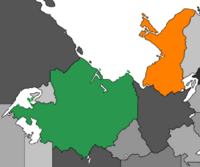Besmenia-Tine relations: Difference between revisions
Jump to navigation
Jump to search
Neuleinster (talk | contribs) No edit summary |
Neuleinster (talk | contribs) |
||
| Line 22: | Line 22: | ||
===Relation with West Besmenia (1920-1967)=== | ===Relation with West Besmenia (1920-1967)=== | ||
===Relation with reunified Besmenia (1967-today)=== | ===Relation with reunified Besmenia (1967-today)=== | ||
When a coalition formed between the conservative [[Besmenian People's Party|BVP]] and the right-wing populist [[Besmenian Republican Party|BRP]] under Prime Minister [[Robert Gleitzmann]] after the [[1972 Besmenian federal election|1972 federal election]] in Besmenia, this aroused international tensions, including in Tine. The Tinegardian government criticized Gleitzmann for the involvement of the BRP, a party that has a partially [[Ochsenbeinism|Ochsenbeinian]] alignment. bilateral relations remained tense until the end of the blue-orange coalition in Besmenia in 1980. | |||
==Economy== | ==Economy== | ||
==Culture== | ==Culture== | ||
Revision as of 18:25, 17 March 2022
 | |
Besmenia |
Tine |
|---|---|
| Diplomatic mission | |
| Embassy of Besmenia, Tinegard | Embassy of Tine, Laitstadt |
| Envoy | |
| Ambassador Christoph Beiter | Ambassador Ulrik Melgaard |
The Besmenia-Tine relations are bilateral relations between Besmenia and Tine.
Country comparision
History
Relation with the Kingdom of Besmenia (1821-1920)
Relation with East Besmenia (1920-1967)
Relation with West Besmenia (1920-1967)
Relation with reunified Besmenia (1967-today)
When a coalition formed between the conservative BVP and the right-wing populist BRP under Prime Minister Robert Gleitzmann after the 1972 federal election in Besmenia, this aroused international tensions, including in Tine. The Tinegardian government criticized Gleitzmann for the involvement of the BRP, a party that has a partially Ochsenbeinian alignment. bilateral relations remained tense until the end of the blue-orange coalition in Besmenia in 1980.